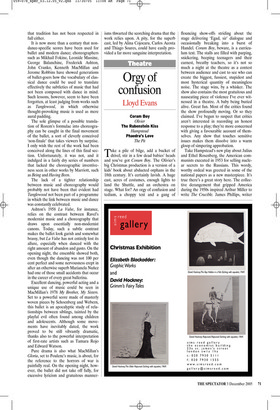Aural padding
Giannandrea Poesio
Royal Ballet Royal Opera House There seems to be a problem with the way some modern-day dance-makers deal with music. Twice in a fortnight, I have been confronted by works in which the score had no relevance to the choreography, and performers seemed to dance to a different tune. I am referring to Rafael Bonachela’s Curious Conscience, reviewed last week, and to Alastair Marriott’s Tanglewood, given its première last Monday by the Royal Ballet.
In line with the assumption that ‘50 per cent of a ballet’s success stems from the right music’, Marriott has opted for an intriguing score, Ned Rorem’s Violin Concerto. As the composer explains in a captivating programme note, this is no traditional violin concerto. Its structure, as well as its thematic and almost narrative content, is the result of some ingenious provocative thinking. So it’s a pity that, in Marriott’s choreographic translation, Rorem’s ideas do not appear to have had any influence on the ballet’s content.
The creation of a movement vocabulary that goes more or less completely against the rhythmical and melodic patterns of the selected music, as well as against the artistic values and notions embedded in the score, is indeed a popular trend in today’s dance-making. Yet such contrasts imply a careful handling of the score, for the successful creation of dissonance between the music and the choreography can only stem from a great knowledge of the former, paradoxical as it may sound. Alas, this is not the case with Marriott, who does not seem to have opted for any dissonance at all, preferring to remain within more traditional creative parameters. It’s a shame that tradition has not been respected in full either.
It is now more than a century that nondance-specific scores have been used for ballet and modern dance; choreographers such as Mikhail Fokine, Leonide Massine, George Balanchine, Frederick Ashton, John Cranko, Kenneth MacMillan and Jerome Robbins have showed generations of ballet-goers how the vocabulary of classical dance could be used to translate effectively the subtleties of music that had not been composed with dance in mind. Such lessons, however, seem to have been forgotten, at least judging from works such as Tanglewood, in which otherwise thought-provoking music is used as mere aural padding.
The sole glimpse of a possible translation of Rorem’s formulae into choreography can be caught in the final movement of the ballet, a sort of cleverly conceived ‘non-finale’ that takes viewers by surprise. I only wish the rest of the work had been conceived along the lines of this final section. Unfortunately, it was not, and it indulged in a fairly dry series of numbers that lacked the choreographic inventiveness seen in other works by Marriott, such as Being and Having Been.
The lack of a tighter relationship between music and choreography would probably not have been that evident had Tanglewood not been part of a programme in which the link between music and dance was constantly celebrated.
Ashton’s 1958 La Valse, for instance, relies on the contrast between Ravel’s modernist music and a choreography that draws upon essentially non-modernist canons. Today, such a subtle contrast makes the ballet look garish and somewhat brassy, but La Valse has not entirely lost its allure, especially when danced with the right amount of abandon and gusto. On the opening night, the ensemble showed both, even though the dancing was not 100 per cent perfect and some nervousness crept in after an otherwise superb Marianela Nuñez had one of those small accidents that occur in the career of every great ballerina.
Excellent dancing, powerful acting and a unique use of music could be seen in MacMillan’s 1978 My Brother, My Sisters. Set to a powerful score made of masterly woven pieces by Schoenberg and Webern, this ballet is an apocalyptic study of relationships between siblings, tainted by the playful evil often found among children and adolescents. Although some movements have inevitably dated, the work proved to be still vibrantly dramatic, thanks also to the powerful interpretation of first-rate artists such as Tamara Rojo and Edward Watson.
Pure drama is also what MacMillan’s Gloria, set to Poulenc’s music, is about, for the reference to the horrors of war is painfully real. On the opening night, however, the ballet did not take off fully, for excessive lyricism and gratuitous manner isms thwarted the scorching drama that the work relies upon. A pity, for the superb cast, led by Alina Cojocaru, Carlos Acosta and Thiago Soares, could have easily provided a far more sanguine interpretation.




























































 Previous page
Previous page